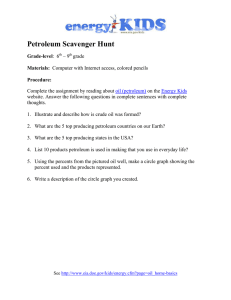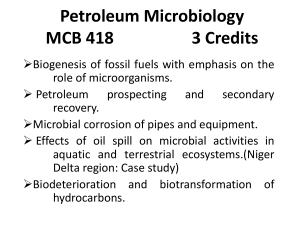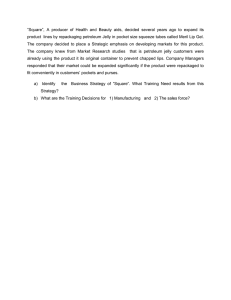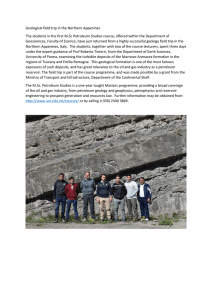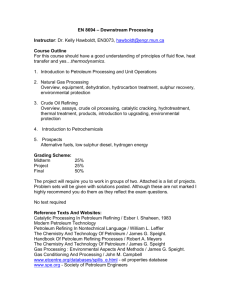Document 13359505
advertisement
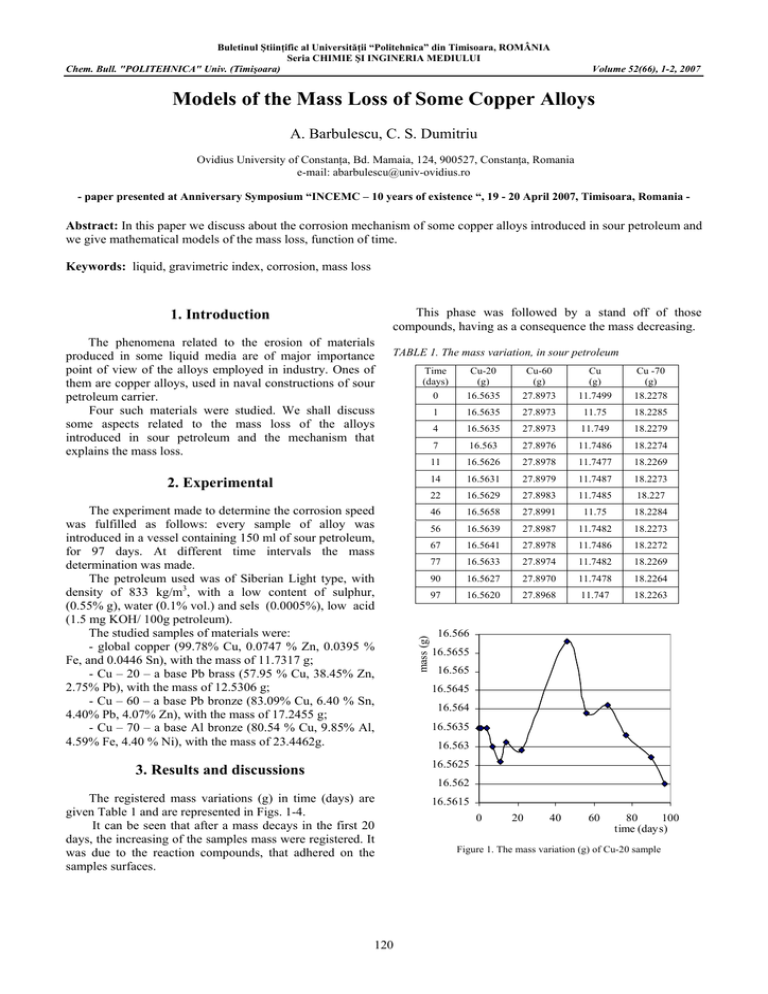
Buletinul Ştiinţific al Universităţii “Politehnica” din Timisoara, ROMÂNIA Seria CHIMIE ŞI INGINERIA MEDIULUI Chem. Bull. "POLITEHNICA" Univ. (Timişoara) Volume 52(66), 1-2, 2007 Models of the Mass Loss of Some Copper Alloys A. Barbulescu, C. S. Dumitriu Ovidius University of Constanţa, Bd. Mamaia, 124, 900527, Constanţa, Romania e-mail: abarbulescu@univ-ovidius.ro - paper presented at Anniversary Symposium “INCEMC – 10 years of existence “, 19 - 20 April 2007, Timisoara, Romania - Abstract: In this paper we discuss about the corrosion mechanism of some copper alloys introduced in sour petroleum and we give mathematical models of the mass loss, function of time. Keywords: liquid, gravimetric index, corrosion, mass loss This phase was followed by a stand off of those compounds, having as a consequence the mass decreasing. 1. Introduction The phenomena related to the erosion of materials produced in some liquid media are of major importance point of view of the alloys employed in industry. Ones of them are copper alloys, used in naval constructions of sour petroleum carrier. Four such materials were studied. We shall discuss some aspects related to the mass loss of the alloys introduced in sour petroleum and the mechanism that explains the mass loss. TABLE 1. The mass variation, in sour petroleum Time (days) 0 Cu-20 (g) 16.5635 Cu-60 (g) 27.8973 1 16.5635 27.8973 11.75 18.2285 4 16.5635 27.8973 11.749 18.2279 The experiment made to determine the corrosion speed was fulfilled as follows: every sample of alloy was introduced in a vessel containing 150 ml of sour petroleum, for 97 days. At different time intervals the mass determination was made. The petroleum used was of Siberian Light type, with density of 833 kg/m3, with a low content of sulphur, (0.55% g), water (0.1% vol.) and sels (0.0005%), low acid (1.5 mg KOH/ 100g petroleum). The studied samples of materials were: - global copper (99.78% Cu, 0.0747 % Zn, 0.0395 % Fe, and 0.0446 Sn), with the mass of 11.7317 g; - Cu – 20 – a base Pb brass (57.95 % Cu, 38.45% Zn, 2.75% Pb), with the mass of 12.5306 g; - Cu – 60 – a base Pb bronze (83.09% Cu, 6.40 % Sn, 4.40% Pb, 4.07% Zn), with the mass of 17.2455 g; - Cu – 70 – a base Al bronze (80.54 % Cu, 9.85% Al, 4.59% Fe, 4.40 % Ni), with the mass of 23.4462g. mass (g) 2. Experimental Cu (g) 11.7499 Cu -70 (g) 18.2278 7 16.563 27.8976 11.7486 18.2274 11 16.5626 27.8978 11.7477 18.2269 14 16.5631 27.8979 11.7487 18.2273 22 16.5629 27.8983 11.7485 18.227 46 16.5658 27.8991 11.75 18.2284 56 16.5639 27.8987 11.7482 18.2273 67 16.5641 27.8978 11.7486 18.2272 77 16.5633 27.8974 11.7482 18.2269 90 16.5627 27.8970 11.7478 18.2264 97 16.5620 27.8968 11.747 18.2263 16.566 16.5655 16.565 16.5645 16.564 16.5635 16.563 3. Results and discussions 16.5625 The registered mass variations (g) in time (days) are given Table 1 and are represented in Figs. 1-4. It can be seen that after a mass decays in the first 20 days, the increasing of the samples mass were registered. It was due to the reaction compounds, that adhered on the samples surfaces. 16.5615 16.562 120 0 20 40 60 80 100 time (days) Figure 1. The mass variation (g) of Cu-20 sample m ass (g) Chem. Bull. "POLITEHNICA" Univ. (Timişoara) Volume 52(66), 1-2, 2007 TABLE 2. The absolute mass variation on surface in sour petroleum 27.8995 27.899 Time (day) Cu-20 (g/m2) Cu - 60 (g/m2) Cu (g/m2) Cu -70 (g/m2) 27.8985 0 0 0 0 0 1 0 0 -0.0387 -0.2819 4 0 0 0.3480 -0.0403 27.8975 7 0.2072 -0.1826 0.5027 0.1611 27.897 11 0.3729 -0.3043 0.8507 0.3624 14 0.1658 -0.3651 0.4640 0.2013 22 0.2486 -0.6085 0.5414 0.3221 46 -0.9531 -1.0954 -0.0387 -0.2416 56 -0.1658 -0.8520 0.6574 0.2013 27.898 27.8965 0 20 40 60 80 100 time (days) mass (g) Figure 2. The mass variation (g) of Cu-60 sample 67 -0.2486 -0.3043 0.5027 0.2416 11.7505 77 0.0829 -0.0609 0.6574 0.3624 11.75 90 0.3315 0.1826 0.8120 0.5637 11.7495 97 0.6216 0.3043 1.1214 0.6040 11.749 11.748 11.7475 1 0.5 11.747 0 11.7465 0 20 40 60 80 time (days) 100 -0.5 Figure 3. The mass variation (g) of Cu sample mass (g) 1.5 g/m 2 11.7485 0 20 40 60 80 100 -1 18.229 -1.5 18.2285 days Cu-20 18.228 Cu-60 Cu Cu-70 Figure 5. The graphs of absolute mass variation on surface in sour petroleum 18.2275 The smaller absolute mass loss on surface was registered by Cu -70 and the biggest, by copper. Using the data from Table 2, we determine the gravimetric indices, defined by: Δm i= , S ⋅ Δt where: - S is the total surface of the sample, - Δm is the total mass loss, - Δt is the time interval. 18.227 18.2265 18.226 0 20 40 60 80 100 time (days) Figure 4. The mass variation (g) of Cu -70 sample Let us denote by: Δmi = m 0 − mi the absolute mass variation, where mi is the mass at the momentul t i , and m0 is the mass at the moment t 0 = 0 . In order to compare the materials mass loss, the absolute mass loss on surface, were determined. The values are given Table 2 and are represented in Fig. 5. 121 In our cases, iCu − 20 = 0.227 ⋅ 10−3 g / m2 ⋅ h , iCu − 60 = 0.13 ⋅ 10−3 g / m2 ⋅ h , iCu − 60 = 0.4798 ⋅ 10−3 g / m2 ⋅ h , iCu − 70 = 0.2259 ⋅ 10−3 g / m 2 ⋅ h . Chem. Bull. "POLITEHNICA" Univ. (Timişoara) Volume 52(66), 1-2, 2007 So, the most resistant alloy was the bronze Cu -60. In order to present the mathematical models obtained for the mass loss on surface, in time, some mathematical concepts must be introduced [1]. If ( y i ) i =1, n a data series, registered at the moments (t i ) i =1, n and f is a regression function, that describes the series evolution, in time, the standard error of the estimate is defined by: n s= ∑(y − f (t i )) 2 i i =1 , (6) n−m where f (t i ) denotes the function value calculated from the regression model and m is the number of parameters in the particular model. The standard error of the estimate quantifies the spread of the data points around the regression curve. As the quality of the data model increases, the standard error approaches zero. Another measure of fit quality is the correlation coefficient. It will be introduced using the standard deviation, defined by: n S t = ∑ ( yi − y) 2 , i =1 where y is the average of the data points, given by: y= 1 n n ∑y . i i =1 St quantifies the spread of the data around a constant line (the mean) as opposed to the spread around the regression model. This is the uncertainty of the dependent variable prior to regression. We also define the deviation from the fitting curve by: n Sr = ∑(y i − f (t i )) 2 , i =1 that measures the spread of the points around the fitting function. Now, using S t and S r , the correlation coefficient is defined by: r= St − Sr . St This is not exactly the classical definition of the correlation coefficient, but it has the same property as the classical one. As the regression model better describes the data, the correlation coefficient will approach unity. Now, using the data given in Table 2, the equations of the mass loss on surface, in time, where determined. They were, respectively: - for Cu - 20: Δm i = −0.06288 + 0.06547t i − 0.00394t i2 + 6.4 ⋅10 −5 t i3 − S − 3.07 ⋅10 −7 t i4 , with s = 0.22712 and r = 0.87327; - for Cu – 60: Δm i = 0.02143 − 0.01547t i − 0.00144t i2 + 3.81 ⋅10 −5 t i3 − S − 2.21⋅10 −7 t i4 , with s = 0.98592 and r = 0.08250; - for copper: Δm i = 0.019404 + 0.08278t i − 0.00359t i2 + 5.29 ⋅10 −5 t i3 − S − 2.43 ⋅10 −7 t i4 , with s = 0.23170 and r = 0.84827; - for Cu -70: Δm i = −0.17405 + 0.065743t i − 0.00304t i2 + 4.72 ⋅10 −5 t i3 − S − 2.26 ⋅10 −7 t i4 , with s=0.15275 and r = 0.88894; Since the standard errors of estimation are small and the correlation coefficients are close to 1, the models are well chosen. In all the cases, the fit functions were polynomials of forth order. From the experiment it results that the corrosion speed was very small. It can be explained having in mind the alloys nature and the liquid used in experiment. The principal components of sour petroleum are the hydrocarbons. It also contains other substances that have carbon, hydrogen, oxygen, nitrogen, metallic ions included in organic–metallic compounds. The compounds with O, S, and N are at the base of the chemical corrosion produced at the contact between the metals or metallic alloys with the sour petroleum. Another component of the petroleum is the water (in small quantities) in which sells (NaCl, CaCl2, MgCl2) are solved [2, 3]. The electrolyte solution is emulsified in sour petroleum and produces the destruction by corrosion, more pronounced at higher temperatures. The corrosion probability in the environment conditions is small because the electrolyte solution is a disperse phase in the hydrocarbons phase. At high temperatures (120 - 1300 C) and pressures (12 bar), the hydrocarbons viscosity decreases, the interfacial pressure also decreases and the drops of aqueous solution are easier deposited, such that the metallic surface will be exposed of the corrosion with an electrochemical mechanism. The corrosion aspects described, due to the sells solved in the water associated to sour petroleum are of importance in petroleum transport at normal temperatures. The nonhydrocarbons – the compounds with nitrogen, oxygen and sulphur – are responsible to the corrosion produced by sour petroleum, even at reduced temperatures. The sulphur exists in an elementary form and is very corrosive. Especially corrosive are also some compounds with sulphur, as H2S and the mercaptan, the organic sulphides, the disulphide, etc [4]. The elementary sulphur, the hydrogen sulfide and the mercaptans produce the corrosion following a chemical 122 Chem. Bull. "POLITEHNICA" Univ. (Timişoara) Volume 52(66), 1-2, 2007 mechanism, by the direct reaction between them and some metals. The copper is given as an example [5]. The compounds with oxygen most susceptible to produce corrosion are the petroleum acids [4]. Between them, the aliphatic acids have the biggest acidity, being the most corrosive. The corrosion produced by them is a chemical one. The compounds with nitrogen from sour petroleum (especially those that exhale ammonia vapors at heating) can also produce a chemical corrosion, by a mechanism described in [6]. The ammonia attacks copper, forming complex compounds, in favorable conditions, as a temperature greater than 1000C. The studied samples of brass, copper and bronzes suffered a chemical due to the presence of the sulphur, of some sulphur compounds (hydrogen sulphur, mercaptans) and of petroleum acids. Also, a passivation of the copper and its alloys were observed – having as a effect a small increasing of the samples mass, at the experiment beginning, followed by a mass stabilization. 4. Conclusions REFERENCES In this paper we gave mathematical models that describe the mass variation in time, for some copper alloys introduced in sour petroleum and to discuss the experimental results. It was proved that the absolute mass loss can be described in all the studied cases by polynomials of forth degree. Since the sour petroleum used for experiment had a small acidity, the corrosion speed was very low. 1. Hyams D., Curveexpert 1.3. Help, Copyright 1995-1997 2. Suciu G., Ingineria prelucrării hidrocarburilor, vol. III, Editura Tehnică, Bucureşti, 1993 3. Tănase I., Analiză instrumentală. Metode electrochimice de analiză, Ed. Tehnică, Bucureşti, 1992 4. Koncsag C., Fizico – chimia petrolului, Ovidius University Press, Constanţa, 2003 5. Neniţescu C., Chimie generală, Editura Didactică şi Pedagogică, Bucureşti, 1977 6. Zamfir S., Vidu R., Brînzoi V., Coroziunea materialelor metalice, Editura Didactică şi Pedagogică, Bucureşti, 1994 ACKNOWLEDGMENT This paper was supported by Grant CNCSIS 902. 123
